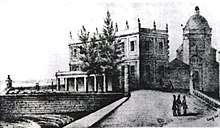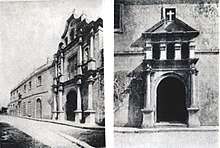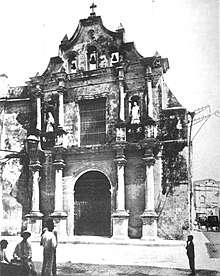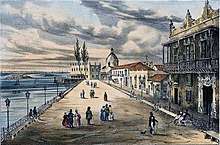Iglesia de San Francisco de Paula, Havana
The Iglesia de San Francisco de Paula, Havana is part of the ecclesiastical heritage of Havana. It is located at 110 Calle Leonor Pérez on the corner of Calle San Ignacio. It is near the bay on the south side of Havana Vieja." [1]
| Iglesia de San Francisco de Paula, Havana | |
|---|---|
 | |

| |
| General information | |
| Type | Religious |
| Architectural style | Baroque |
| Address | 110 Leonor Pérez |
| Town or city | Havana |
| Country | Cuba |
| Coordinates | 23°07′52″N 82°20′56″W |
| Groundbreaking | 1664 |
| Construction started | 1731 |
| Renovated | 1760 |
| Technical details | |
| Structural system | Load bearing |
| Material | Masonry |
History

.jpg)


Towards the end of the 17th century, the first stone of what would be the hospital for women and the church of San Francisco de Paula was placed, the buildings were expanded in 1731 with the support and donations from the City Council and orders of the different General Captains in command of the island. In 1776, it was the most important hospital in Havana, there were several generations of famous doctors that trained here.[2]
Building
The Presbyter of the Cathedral of Havana, don Nicolás Estévez Borges, in 1664 ordered the construction of a Hospital for Women and an adjoining church devoted to Saint Francis of Paola who was one of the founders of the Roman Catholic Order of the Minims. San Francisco de Paula (1416-1507) was a hermit, famous for his humility and his miracles. His party is celebrated on April 2.
Both buildings were completely destroyed by a hurricane in 1730 and were rebuilt and enlarged in 1745 in the Baroque style we see today, resulting in the Royal Hospital of Havana and the Church of San Francisco de Paula.[3]
National monument
The Havana Central Railroad, a U. S. company, in 1907 attempted to acquire the temple for its own corporate use. The Central Railroad’s several attempts to acquire and eventually demolish the church were frustrated by the opposition of historian Emilio Roig de Leuchsenring and anthropologist don Fernando Ortiz. Their efforts not only stopped the demolition of the church but also got it listed as National Monument in 1944. Havana Central Railroads, however, was able to bring down the hospital upon approval from the relevant authorities at the time.
An example of the pre-Churrigueresque Baroque style, the floor plan of the Iglesia de San Francisco de Paula is typologically similar to the Iglesia de San Francisco de Asís as both ground plans are based on a Latin cross. The façade has a central arched doorway and columns at the sides, typical of Spanish churches. There is a belfry in the front, but the 3 bells were never be recovered after the hurricane of 1730. The Office of the City Historian restored the stained glass windows.[4]
Restoration

The Iglesia de San Francisco de Paula is a representative example of the Cuban Baroque of the first half of the 18th century. The portion of the church that still exists, the octagonal base of the dome, the façade, and the stained glass windows, all part of the original building of 1745, have all been restored. The facade is similar to that of the church of Santo Domingo, in Guanabacoa and the convent of San Francisco de Asís, built on a similar date. The nave has a barrel vault and a dome that marks the crossing. As an altarpiece, it has a stained glass window in the city and the only organ that has been preserved in Cuba with the original pipe and machinery,\ in its original location. In the church are preserved the ashes of the great Cuban violinist Claudio José Brindis de Salas (1852-1911), considered one of the best violinists of his time.[3]
La Alameda de Paula
The Alameda de Paula was the first promenade in Cuba, designed and constructed in 1776 by Antonio Fernández Trevejo, following the instructions of the Laureano de Torres y Ayala, it was created on the site of the old Rincón refuse dump. It was a was an embankment with two rows of poplar trees and some benches, it became one of Havana's most important social and cultural spaces, it was the model of the Paseo del Prado designed in 1925. It was given the name Alameda de Paula because of its proximity to the old Hospital and Iglesia of San Francisco de Paula. Between 1803 and 1805 the pavement was tiled, a fountain and stone benches, lampposts and the marble column were added, it qualified as a pleasant entertainment for the residents of the Villa de San Cristóbal, lacking recreational sites at that time.
In 1841, the stairs that gave access to the promenade were widened and several lampposts were added. In the year 2000, the Havana promenade was restored and extended until it reached the Iglesia de San Francisco de Paula.[3]
See also
References
- "Iglesia de San Francisco de Paula, La Habana". Retrieved 2019-01-03.
- "Antigua Iglesia de San Francisco de Paula". Retrieved 2019-01-03.
- "La Iglesia de San Francisco de Paula". Retrieved 2019-01-06.
- "Iglesia de San Francisco de Paula". Retrieved 2019-01-05.
